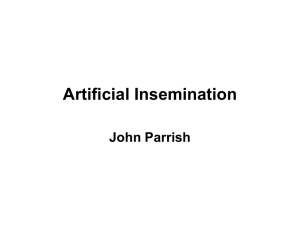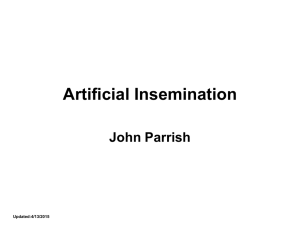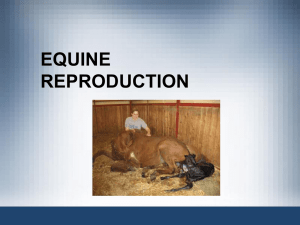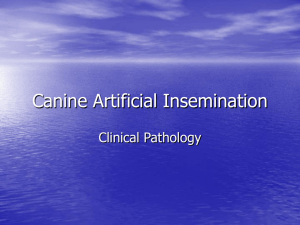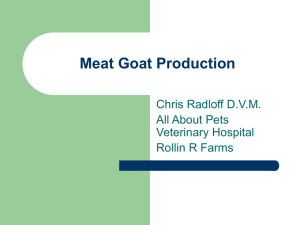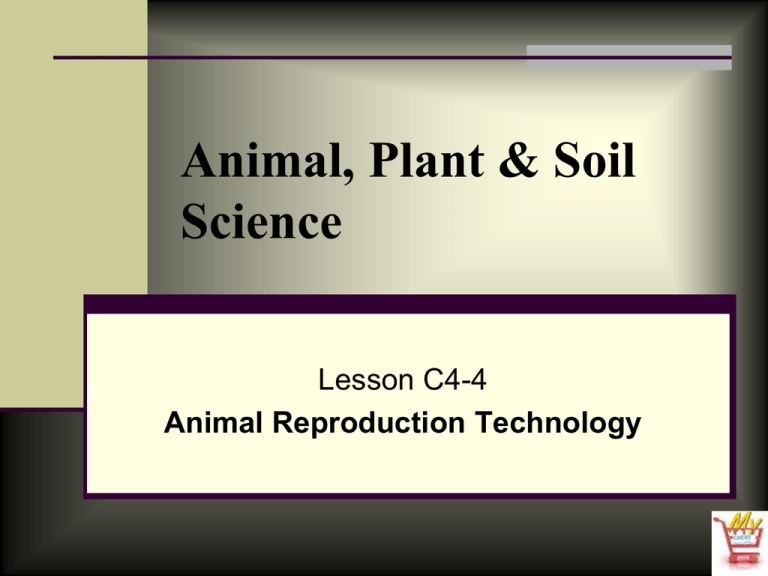
Animal, Plant & Soil
Science
Lesson C4-4
Animal Reproduction Technology
Interest Approach
Place some of the equipment needed to
perform artificial insemination in the front of
the classroom. Ask students if they can
identify the uses of the various tools. Lead the
discussion into the first objective of the
lesson.
Objectives
Describe the process of artificial
insemination in common agricultural
animals, including the collection,
evaluation, extension, and storage of
semen.
Recognize signs of estrus, and identify
methods or technology used to detect
estrus in common agricultural animals.
Objectives
Determine the optimal breeding times and
optimal placement of semen deposition in
common agricultural animals.
Discuss the advantages and
disadvantages of artificial insemination
and natural breeding.
Define the process of estrous
synchronization, semen sexing, embryo
transfer, cloning, and genetic engineering.
Terms
artificial
insemination
cloning
donor female
embryo transfer
estrous
synchronization
genetic engineering
progestin
prostaglandin
recipient female
semen collection
semen evaluation
semen extension
semen storage
sexed semen
standing heat
superovulation
What are the steps involved
in artificial insemination?
Artificial insemination is the placing of
semen in the female reproductive tract by
artificial techniques.
The use of this technique
has increased over the past
several years due to
advancements in technology.
The process varies by species, but it typically
involves specialized equipment and a trained
technician.
What are the steps involved
in artificial insemination?
The technician deposits a prepared unit of
semen into the reproductive tract of the
female at a predetermined time.
The objective of artificial insemination is to
deposit the semen at the appropriate time to
achieve fertilization.
Timing varies by species of animal and
should be closely studied prior to
implementing artificial insemination.
What are the steps involved
in artificial insemination?
There are several different segments that
support the process of artificial insemination.
Some of the major segments include:
A. Semen collection—Artificial insemination
requires that semen be collected
from the male.
Semen may be collected
via manual stimulation or the
use of an artificial vagina.
The technique used depends on the species
from which the semen is being collected.
What are the steps involved
in artificial insemination?
Manual stimulation involves the use of an
electronic probe to encourage ejaculation.
While this process produces a semen sample, it
has been determined that a more appropriate
sample can be collected if the male is stimulated.
This can be achieved by utilizing an artificial
vagina.
It involves allowing the male to mount a dummy
animal and inserting the penis into an artificial
vagina.
This process more closely simulates naturally
breeding, resulting in a higher quality semen
sample.
What are the steps involved
in artificial insemination?
B. Semen evaluation—After semen is
collected from the male, it
is evaluated for quality.
Only the highest quality
semen is utilized for
artificial insemination.
The semen must be evaluated under a
microscope to verify that it contains an
appropriate number of living sperm cells.
If approved for use, the sperm is then
processed to increase utilization.
What are the steps involved
in artificial insemination?
C. Semen extension—Semen is extended
during the processing phase, which allows for
a single collection to be
divided into many units.
Only one unit is required for
artificial insemination; by extending it, the
semen can be used for several breedings.
To extend semen, specialized compounds are
added to enhance the viability and storage of
the sperm cells.
Depending on the species, often nutrients are
added to expand the mass of each semen
unit.
What are the steps involved
in artificial insemination?
D. Semen storage—Semen is stored in one
of two ways.
It is either frozen to extremely low
temperatures or maintained fresh until use.
How semen is stored depends on the species.
For example, cattle semen is slowly cooled
and frozen at a temperature of –320°F (–
196°C).
Liquid nitrogen is used to obtain these
extreme temperatures.
What are the steps involved
in artificial insemination?
Properly frozen and stored semen can remain
viable and be used 30 to 40 years later.
The frozen semen is thawed prior to use in a
95 to 98°F (33 to 34°C) water bath.
It is then ready to be deposited in the female.
Fresh semen cannot be stored for such long
periods of time.
For example, collections from pigs are kept at
approximately 60°F (16°C) for two to four days.
Fresh semen becomes less fertile over time,
so immediate use improves the chances of
successful insemination.
What are the steps involved
in artificial insemination?
What are some signs of estrus,
and how is estrus detected?
Estrus detection is a crucial part of a successful
artificial insemination program.
Producers must be able to
determine when females are at
the appropriate reproductive
stage to be inseminated.
Proper estrus detection results in a higher success
rate for pregnancies and increases the efficiency of
artificial insemination.
In order to detect estrus, producers must be able to
identify physical signs expressed by animals.
Some producers may utilize new technology to aid in
the process.
What are some signs of estrus,
and how is estrus detected?
A. Detecting estrus—To insure high
conception rates, the artificial insemination
technician must be able to detect when the
female is in estrus (heat).
Estrus signs vary between species.
The best indication of estrus for most species is
standing heat, which is the stage of estrus when
a female stands when mounted by another animal.
By standing to be mounted, the female is
expressing that she is at the appropriate stage of
her reproductive cycle and is prepared to be
inseminated at a predetermined time.
What are some signs of estrus,
and how is estrus detected?
Many times the female will not stand for the
first few hours, will try to mount other animals,
and will be very active among a group of
animals.
It is important to view the animals every few
hours to determine if they are experiencing a
standing heat.
Many times prior to standing or shortly after
standing, heat animals will express the same
characteristics.
Frequent observations can help to determine if
the female is coming in or going out of the
standing heat phase.
What are some signs of estrus,
and how is estrus detected?
Many animals display extra mucus and
redness in the vulva when experiencing
estrus, which can be visually evaluated and
used as indicators of when
to artificially inseminate
animals.
Estrus characteristics
should be studied for
specific animals when
utilizing artificial insemination.
It will aid producers in identifying which
characteristics should be observed prior to
breeding.
What are some signs of estrus,
and how is estrus detected?
B. Technology in estrus detection—One of
the disadvantages of using artificial
insemination is that it requires estrus
detection.
The most common method used to detect
estrus is observing the animals several times
throughout the day.
It is very time consuming and can lack
consistency, especially in poor weather
conditions.
Recently there have been technology
advancements to detect estrus.
What are some signs of estrus,
and how is estrus detected?
1. Paint markers have been designed to
place marks on an animal when she is
experiencing estrus.
The paint marker is placed on an
accompanying animal in the pen.
When the companion animal
mounts the animal in estrus, the
marker leaves identifying marks
on the animal’s back, sides, and
rump region.
What are some signs of estrus,
and how is estrus detected?
2. Specialized pressure patches have been
developed to identify when an animal is in a
standing heat.
The patch changes color
when an accompanying
animal mounts the
animal in estrus for a
period of time.
What are some signs of estrus,
and how is estrus detected?
3. Advanced computer technology has been
developed to detect estrus.
The use of specialized radio transmitters can
help producers.
Animals are fitted with patches that transmit a
radio signal when the animal is mounted.
The computer program records the date, time,
and duration of the mounting.
It then sorts the data recorded and identifies
when the animal is experiencing a standing
estrus.
What are some signs of estrus,
and how is estrus detected?
4. The newest and developing means of
estrus detection is through the use of blood,
milk, and bodily fluid tests.
These tests measure certain
levels of hormones in the fluid
to determine the reproductive
cycle stage.
The test is performed over
several days and can be used
to determine when the female
is approaching a standing heat.
What are the various optimal breeding
times and placement of semen in
common agricultural animals?
To have a successful artificial insemination
program, a technician must deposit semen in
the reproductive tract of a female at the
appropriate time.
The female must be experiencing estrus.
In addition, the female must have displayed a
standing heat.
Then the technician must place the semen at
the appropriate location for the sperm cells to
fertilize the female’s egg.
The optimal breeding time and placement of
the semen varies by species.
What are the various optimal breeding
times and placement of semen in
common agricultural animals?
A. The use of artificial insemination is
common in beef and dairy cattle.
The process of determining
when to inseminate cattle
has been tweaked over time,
but it is typically agreed that
artificial insemination should
occur approximately 12 hours after a standing
heat is detected.
What are the various optimal breeding
times and placement of semen in
common agricultural animals?
The semen is deposited in the uterine body of
the cow by passing a pipette through the
vagina and cervix.
The technician must palpate the cow rectally
and be able to feel the tip of the pipette in the
uterine body.
Cattle are usually inseminated once with a
single unit of semen.
What are the various optimal breeding
times and placement of semen in
common agricultural animals?
B. The swine industry also frequently utilizes
artificial insemination in breeding programs.
Sows and gilts will experience a standing heat
for up to three days.
During this time, frame
technicians will
inseminate the female
daily for two or three days.
Ideally, insemination will occur 10 to 12 hours
prior to ovulation.
What are the various optimal breeding
times and placement of semen in
common agricultural animals?
The semen is deposited in the uterine body of
the female by passing a specialized catheter
through the vagina into the cervix.
The catheter is ribbed to
simulate the boar penis
and allow for the female’s
cervix to grip the catheter.
Once the semen unit is
deposited, the female will relax the cervix and
release the catheter.
What are the various optimal breeding
times and placement of semen in
common agricultural animals?
C. The use of artificial insemination in horses
is increasing rapidly.
Much like cattle and swine,
the semen is deposited in
the uterine body by using
a specialized pipette.
The technician guides the pipette through the
vagina and into the cervix to deposit the
semen.
What are the various optimal breeding
times and placement of semen in
common agricultural animals?
The timing of insemination is determined by
palpating the horse’s ovaries to determine the
stage of the reproductive cycle when the mare
is experiencing estrus.
Once all indicators determine that the mare is
ready for breeding, she may be injected with a
synthetic hormone to enhance ovulation.
Ideally, insemination will occur 12 to 16 hours
prior to ovulation.
What are the various optimal breeding
times and placement of semen in
common agricultural animals?
D. The sheep industry has not adopted
artificial insemination at a high rate.
Therefore, sheep producers rely
on nature for proper timing and
placement of semen in the
reproductive process through
natural breeding.
Researchers continue to explore
options for use, but they have been
unable to create a practice that is as
successful or as simple to apply as in other
species.
What are the various optimal breeding
times and placement of semen in
common agricultural animals?
E. Nearly 100 percent of all
commercial turkeys are
inseminated artificially.
This is due to breeding
practices and the limitations
that have developed to
prevent natural mating.
Fortunately, the timing and
placement is much simpler
than that of other species.
What are the various optimal breeding
times and placement of semen in
common agricultural animals?
During the laying season, hens are
inseminated with semen every 10 to 14 days.
Because turkeys do not experience estrus, the
only requirement is that the hen is frequently
laying eggs.
The semen is deposited in the oviduct with a
small straw and is stored there as needed to
fertilize eggs.
What are the advantages and
disadvantages of artificial
insemination and natural breeding?
As with all management practices in livestock
production, there are several advantages and
disadvantages of using artificial insemination.
The same is true in the case
of natural breeding.
Both should be evaluated
to determine which fits best
in a breeding program.
A. Some of the advantages of utilizing
artificial insemination are:
What are the advantages and
disadvantages of artificial
insemination and natural breeding?
1. Increases the use of outstanding sires—
Through artificial insemination, many
producers can use an outstanding sire to
breed their females.
The actual sire does not need to be present.
2. Eliminates the danger of keeping a sire—
Some hazards are usually involved in
keeping a sire on site.
Also sires, when not breeding, are typically
kept in separate facilities.
This need is eliminated with the use of artificial
insemination.
What are the advantages and
disadvantages of artificial
insemination and natural breeding?
3. Reduce sire costs—In smaller herds,
artificial insemination is usually less
expensive than the ownership
of a quality sire due to
building, feed, and labor costs.
4. Increase the number of
different sires in the herd—
Through artificial insemination, it is possible
to introduce several different genetic lines
into the herd through the use of different
sires.
What are the advantages and
disadvantages of artificial
insemination and natural breeding?
B. Some of the disadvantages or limitations of
artificial insemination are:
1. Requires skilled technician—To be
successful, artificial insemination must be
carried out by a person who has received
training and has experience.
2. High initial investment—Considerable
money is necessary to begin an artificial
insemination operation.
What are the advantages and
disadvantages of artificial
insemination and natural breeding?
3. Equipment costs can be high in addition to
the training needed to conduct the procedure.
4. Increase management—To be successful,
the level of observation and management by
the producer must increase in an artificialinsemination operation.
What are the advantages and
disadvantages of artificial
insemination and natural breeding?
C. Some of the advantages of utilizing natural
breeding include:
1. Lower management requirements—
Allowing animals to breed naturally requires
little management input outside of exposing
male and female animals.
2. Uniformity among offspring—By utilizing a
limited number of sires through natural
breeding, offspring will share similar genetic
traits, which typically results in the offspring
growing at the same rate.
What are the advantages and
disadvantages of artificial
insemination and natural breeding?
3. Maximizing the investment of breeding
animals—Purchasing sires is expensive.
Allowing them to breed
more animals naturally
aids in better utilizing the
animals in a herd.
4. Higher success rate of
breeding—Higher
conception rates can be
expected by allowing
animals to breed naturally.
What are the advantages and
disadvantages of artificial
insemination and natural breeding?
D. Some of the disadvantages of utilizing
natural breeding include:
1. Danger of aggressive sires—
Male animals can become
extremely aggressive during the
breeding season, resulting in a
dangerous situation for the
producers who work with the
animals during this time.
What are the advantages and
disadvantages of artificial
insemination and natural breeding?
2. Slow genetic improvement—Natural
breeding only allows for the use of genetics
from the sires owned, which slows genetic
improvement unless new sires are purchased
each breeding season.
3. Cost of maintaining sires—To use natural
breeding, the sires must be fed and
maintained year around, which increases
costs due to the expense of feed and health
management.
What are the advantages and
disadvantages of artificial
insemination and natural breeding?
4. Higher probability of poor traits—If a sire is
utilized to breed several animals naturally in a
herd, there is a chance that poor traits could
be passed to all offspring.
For example, high birth
weight could be a trait of
a sire, resulting in
birthing problems for all
females.
What are the processes of estrous
synchronization, semen sexing, embryo
transfer, cloning, and genetic engineering?
Several other techniques are used in animal
reproduction in addition to
artificial insemination.
Some of the more common
techniques are:
A. Estrous synchronization—Estrous
synchronization is bringing a group of
animals into heat simultaneously, which is
done to assist the producer in scheduling
animal breeding and birthing.
What are the processes of estrous
synchronization, semen sexing, embryo
transfer, cloning, and genetic engineering?
Synchronization usually involves the use of
prostaglandin, progestin, or a combination of
the two.
The hormone prostaglandin causes the
corpus luteum to stop producing progesterone,
which allows the animal to come into estrus.
The hormone progestin has the effect of
keeping progesterone levels high, holding
animals in an extended diestrus.
When the progestin source is removed, the
animal quickly comes into estrus.
What are the processes of estrous
synchronization, semen sexing, embryo
transfer, cloning, and genetic engineering?
B. Sexed semen—The sex of the offspring
produced through artificial insemination can
be controlled by the producer
through the use of sexed semen.
Sexed semen is semen that has
been prepared to produce all
male or all female offspring.
It is collected in the same manner as other
semen used in artificial insemination.
Once collected, the semen is processed using
sophisticated equipment that sorts the X
chromosomes from the Y chromosomes.
What are the processes of estrous
synchronization, semen sexing, embryo
transfer, cloning, and genetic engineering?
It is then packaged as either all X
chromosome semen to produce female
offspring or all Y chromosome semen to
produce male offspring.
Generally sexed semen will predict sex with
approximately 90 percent accuracy.
The cost of sexed semen is normally about
four times higher than the cost of unsexed
semen.
What are the processes of estrous
synchronization, semen sexing, embryo
transfer, cloning, and genetic engineering?
C. Embryo transfer—Embryo transfer is
moving embryos from one female, called the
donor female, to the reproductive tract of
another female called the recipient female.
Donor females usually carry
extraordinary genetics.
Recipient animals have far
less worth and are used as
surrogate mothers.
Embryo transfer is used following
superovulation.
What are the processes of estrous
synchronization, semen sexing, embryo
transfer, cloning, and genetic engineering?
Superovulation involves getting a female to
release more than the usual number of eggs
during a single estrous cycle.
Embryos can be
frozen in liquid
nitrogen and
transferred later;
however, the success
rate is higher when
transferring fresh
embryos.
What are the processes of estrous
synchronization, semen sexing, embryo
transfer, cloning, and genetic engineering?
D. Cloning—Cloning is the production of one
or more exact genetic copies of an animal.
There are several methods of cloning
animals.
1. One method of cloning
involves letting embryos
grow to the 32-cell stage
before splitting into two
identical embryos.
What are the processes of estrous
synchronization, semen sexing, embryo
transfer, cloning, and genetic engineering?
2. Another method involves taking the DNA
from an adult animal and transferring it to an
embryo that has had its DNA information
removed.
The embryo is then stimulated through
chemicals and other techniques to encourage
division.
After a period of time, it is transferred to a
recipient mother to continue to grow and
develop until birth.
This method was used in creation of the
famous sheep named Dolly.
What are the processes of estrous
synchronization, semen sexing, embryo
transfer, cloning, and genetic engineering?
3. A third technique involves taking cells from
primordial germ cells during fetal
development.
These are more stable
cells and can be cultured
and frozen for indefinite
periods of time.
The germ cells can be stimulated to divide
rapidly and can grow to create identical cells.
What are the processes of estrous
synchronization, semen sexing, embryo
transfer, cloning, and genetic engineering?
E. Genetic engineering—Genetic
engineering is removing,
modifying, or adding
genes to DNA.
Genetic engineering
using gene-splicing or
recombinant DNA, along
with other reproductive
technology, will have a
great deal of impact on
future animal production.
Review
What are the steps involved in artificial
insemination?
What are some signs of estrus, and how is
estrus detected?
What are the various optimal breeding times
and placement of semen in common
agricultural animals?
Review
What are the advantages and disadvantages
of artificial insemination and natural
breeding?
What are the processes of estrous
synchronization, semen sexing, embryo
transfer, cloning, and genetic engineering?

